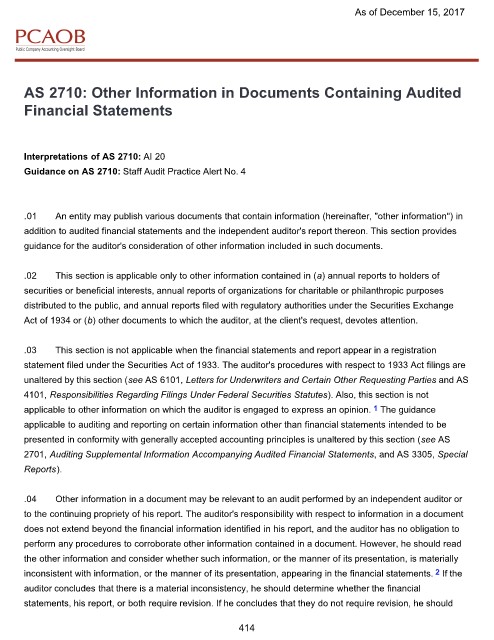Page 417 - Auditing Standards
P. 417
As of December 15, 2017
AS 2710: Other Information in Documents Containing Audited
Financial Statements
Interpretations of AS 2710: AI 20
Guidance on AS 2710: Staff Audit Practice Alert No. 4
.01 An entity may publish various documents that contain information (hereinafter, "other information") in
addition to audited financial statements and the independent auditor's report thereon. This section provides
guidance for the auditor's consideration of other information included in such documents.
.02 This section is applicable only to other information contained in (a) annual reports to holders of
securities or beneficial interests, annual reports of organizations for charitable or philanthropic purposes
distributed to the public, and annual reports filed with regulatory authorities under the Securities Exchange
Act of 1934 or (b) other documents to which the auditor, at the client's request, devotes attention.
.03 This section is not applicable when the financial statements and report appear in a registration
statement filed under the Securities Act of 1933. The auditor's procedures with respect to 1933 Act filings are
unaltered by this section (see AS 6101, Letters for Underwriters and Certain Other Requesting Parties and AS
4101, Responsibilities Regarding Filings Under Federal Securities Statutes). Also, this section is not
1
applicable to other information on which the auditor is engaged to express an opinion. The guidance
applicable to auditing and reporting on certain information other than financial statements intended to be
presented in conformity with generally accepted accounting principles is unaltered by this section (see AS
2701, Auditing Supplemental Information Accompanying Audited Financial Statements, and AS 3305, Special
Reports).
.04 Other information in a document may be relevant to an audit performed by an independent auditor or
to the continuing propriety of his report. The auditor's responsibility with respect to information in a document
does not extend beyond the financial information identified in his report, and the auditor has no obligation to
perform any procedures to corroborate other information contained in a document. However, he should read
the other information and consider whether such information, or the manner of its presentation, is materially
2
inconsistent with information, or the manner of its presentation, appearing in the financial statements. If the
auditor concludes that there is a material inconsistency, he should determine whether the financial
statements, his report, or both require revision. If he concludes that they do not require revision, he should
414

